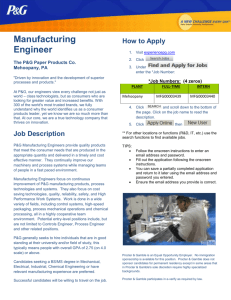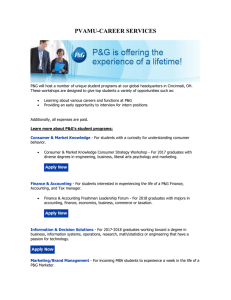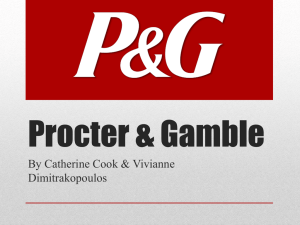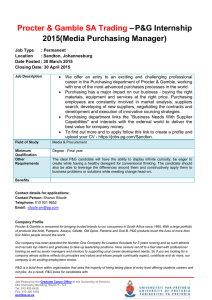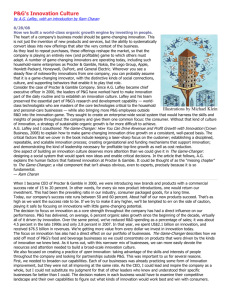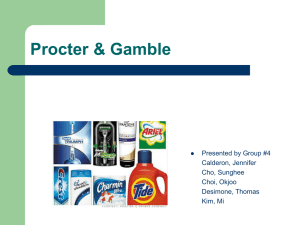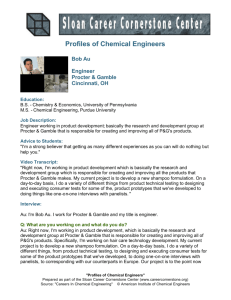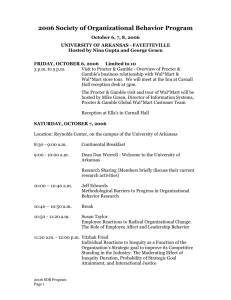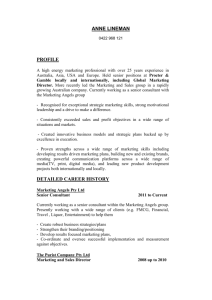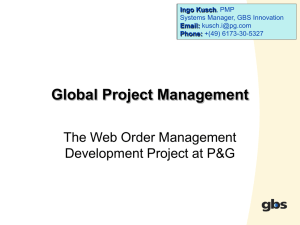UNIVERSITY OF GHANA BUSINESS SCHOOL INFORMATION
advertisement
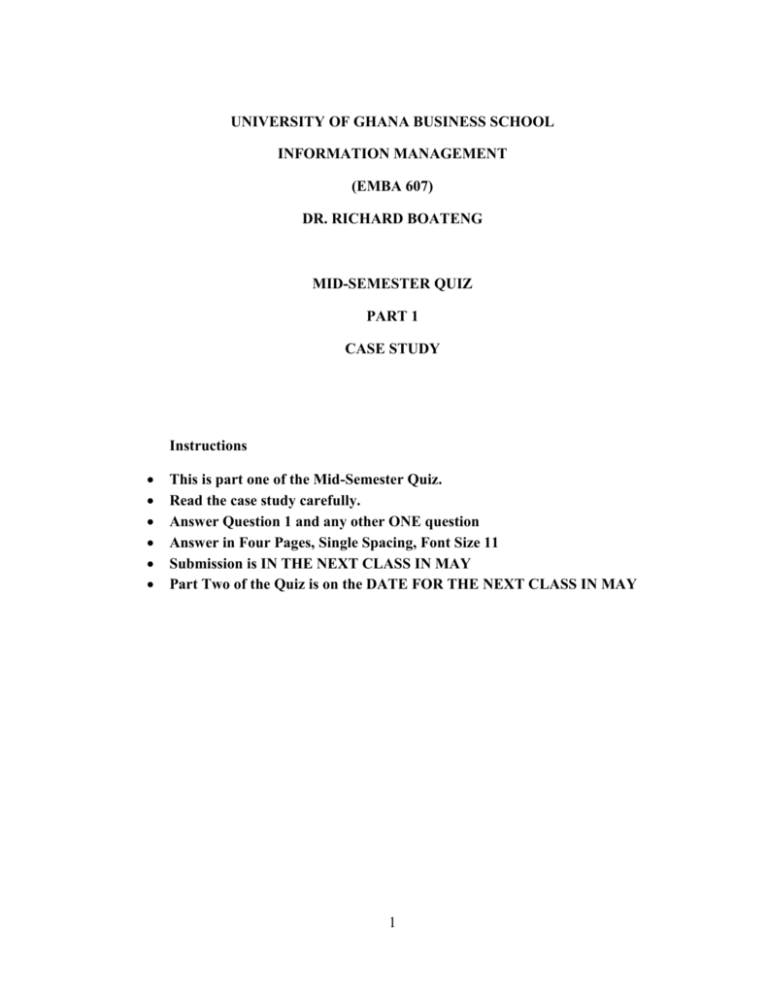
UNIVERSITY OF GHANA BUSINESS SCHOOL INFORMATION MANAGEMENT (EMBA 607) DR. RICHARD BOATENG MID-SEMESTER QUIZ PART 1 CASE STUDY Instructions This is part one of the Mid-Semester Quiz. Read the case study carefully. Answer Question 1 and any other ONE question Answer in Four Pages, Single Spacing, Font Size 11 Submission is IN THE NEXT CLASS IN MAY Part Two of the Quiz is on the DATE FOR THE NEXT CLASS IN MAY 1 Can Knowledge Systems Help Procter & Gamble Stay Ahead of the Pack? Procter & Gamble (P&G), the 166-year-old consumer goods giant, traditionally aimed at doubling its sales every decade. P&G has four major business units: health and beauty, babies, snacks and beverages, and fabric and home care. It offers more than 300 products, including major brands such as Tide, Mr. Clean, Ivory Soap, Crest, Pringles, Pampers, Clairol, and Prell. According to Advertising Age, P&G spends more on advertising worldwide than any other corporation. Currently, P&G is doing about $40 billion in sales annually. For most of its history, P&G was a leader and innovator in marketing and brand management. But by the late 1990s, its annual growth rate slowed from 5 to 2.6 percent. Despite repeated decades of rapid growth, P&G came to be seen as unimaginative, even stodgy. It had a reputation for being closed to outside ideas and it seemed weak on developing new products and getting them quickly into the marketplace. The only new product that had been developed during the previous 15 years was the Swiffer dust mop. Traditional competitors, such as Kimberly Clark and Colgate Palmolive, with comparable branded products were taking away market share. And makers of generic versions of soap, laundry detergent, and toilet paper were selling their products for much less than P&G’s Ivory Soap, Tide, or Charmin. Adding to cost pressures was the purchasing power of Wal-Mart, P&G’s largest customer, which currently accounts for nearly 20 percent of its sales and could be responsible for one-third of P&G global sales by 2010. Wal-Mart is legendary for squeezing costs out of its suppliers and expecting them to coordinate their supply chain processes with its powerful justin-time continuous inventory replenishment system (described in Chapter 3). When A. J. Lafley took over as P&G’s CEO in June 2000, he embarked on a plan to revitalize the company. P&G was to find better ways of doing what it did well—selling its major brands—but doing so in more flexible, innovative, and costconscious ways. P&G was to accelerate internal efforts and work with groups outside the company to develop ideas for new products or extensions of existing product lines, to become more flexible and responsive to customers, and to find new ways of reducing operating costs. Before Lafley became CEO, P&G often relied on price increases to meet its quarterly earnings targets. Knowledge management and knowledge management systems are helping the company achieve these goals. P&G is now becoming a knowledge-driven company with information systems to support knowledge management. It is focusing on the use of knowledge in at least four areas: development, marketing, sales, and customer relations. P&G established an intranet called InnovationNet, which is used to bring people together who are working on similar problems in order to generate synergy for new product ideas and product development. The system connects those working in research and development (R&D), engineering, purchasing, marketing, legal affairs, and business information systems around the world, including more than 1,200 Ph.D.-level scientists. The intranet uses a portal to provide browser-based access to published information, such as documents, reports, charts, videos, and other data from various sources. In 2001, P&G added qualified experts to the pool of information resources on InnovationNet using AskMe Enterprise knowledge network software. Based on the amount of involvement of particular workers in certain subjects, the system creates a directory of subject- 2 matter experts who can be called on to give advice or collaborate on problem solving and product development. After a period of time, experts are highlighted by the system, which creates an implicit reward system. The software automatically adds expert answers to an archive of solutions and best practices. This way, experts need not respond to the same question multiple times. That same year the InnovationNet group created its “connect-anddevelop” program to bring outsiders onto InnovationNet. These outsiders include not only research scientists but also about 150 entrepreneurs who are searching for new, innovative products worldwide. The site now has 18,000 users globally and is storing more than 9 million documents online. Users can search for both documents and individual knowledge experts using the Google and AskMe search engines. Virtual Learning @ Procter & Gamble is a very small information technology group that uses high-end graphics technology similar to that used in the movie Toy Story to develop the concepts, designs, packaging, and marketing for potential new products. The group also works with a marketing company called Cre8 in Europe to put together virtual presentations that demonstrate new concepts, to rapidly prototype new features for current products, and even to test how consumers react to alternative shelf-space designs. P&G has been aggressively using product lifecycle management (PLM) software since 2000 for new product development. The company uses MatrixOne software for mechanizing and automating the knowledge components, and the flow components, within the bringing-aproduct-tomarket phases. Before MatrixOne, P&G used 8 IT systems and 29 work processes. Now, it has only one database to store and manage its product specifications. This database includes information about work processes vital for creating, reviewing, approving, and distributing products. It holds specifications for everything from raw materials to test methods to packaging and even to clearances from the countries where a product will be sold. About 8,000 employees from many business units are now using the database, and Steve David, the CIO at P&G, is very pleased at how well his company is doing with the software. It enabled P&G to lower its costs on items such as pigments, chemicals, and packaging materials used across multiple products and divisions. The company has even been able to reduce development time by reusing specifications that the Food and Drug Administration (FDA) has already approved. Marketing involves innovation and creativity and in the past was ignored as an area that could benefit from using information technology because it was considered too complex and personalized. However, according to The Gartner Group, the Connecticut-based information system consulting firm, companies spend between 15 and 35 percent of their revenue on marketing. One issue has been the fact that P&G’s various brands, product lines, customers, and even different marketing groups each use their own independent software for some functions, including direct mail, e-mail, and marketing campaign management. Lafley’s revitalization strategy also called for using Internet technology as much as possible for product development, marketing, sales, and any other activities where it could strengthen P&G’s share of the market. P&G has set up a series of Web sites that help it promote 3 existing brands and that are used for testing and marketing new products. P&G now conducts much of its market research and surveying online, using MarketTools Inc.’s zTelligence. As a result, online marketing research has mostly eliminated focus groups that were previously used for its early-stage analysis of new products. CIO Steve David said, “We do almost 100 percent of our concept testing online now.” The company used to spend about $150 million every year to conduct 6,000 surveys. Conducting its surveys on the Net is not only less expensive but it is also 75 percent faster. As Barb Lindsey, the director for consumer research services, explains, “People spend their whole lives developing products and concepts; they want to learn as fast as they can.” However, the company experienced some difficulty using the Internet to share marketing ideas. For example, if a marketing unit in Australia develops an effective way to launch a new product, such as Febreze fabric spray, it is difficult to share its idea with similar groups in other countries. According to Jim Stengel, P&G’s global marketing officer, “We have very bright marketing people who have success stories developing throughout the world, but we lack a systematic way of sharing and reapplying their thinking quickly.” Another problem was the lack of adequate information for a marketing campaign. Stengel explained, “Ironically, despite all the data we generate as a company or within a specific global brand, we find ourselves sometimes making decisions based on incomplete data because the data isn’t where we need it, when we need it.” A third issue, according to Stengel, is “Our [failure] to use many of the same marketing principles and tools [we use on consumers] on ourselves, to change our work habits and practices, as we roll out the [marketing software] platform on a brand-by-brand basis.” The solution was a single software system that covers all of P&G’s marketing. It would support all activities, from strategic planning to research, advertising, direct mail, and events. It could collect all relevant data (from the front and back offices within the company and also relevant information from outside the company); store, distribute, and monitor that information; and track marketing projects, analyzing them and assessing their impact on the business. This would also operate as P&G’s marketing memory. P&G joined with two other companies— Worldwide Magnifi of Cupertino, California, and San Francisco’s BrandCities—to establish Emmperative, a company developing marketing resource management software. It is one of only two vendors producing comprehensive software for marketing. By using this software, Stengel expects the day-to-day work of the marketers to be more satisfying because they will be able to “focus on creative results-oriented marketing rather than time-consuming administrative tasks.” This, in turn, should result in stronger, more creative, and more successful marketing plans. For a number of years P&G has focused on ways to improve supply chain efficiency and costs; it now has a powerful industrial network linking it electronically to major suppliers and customers (see Chapter 2). It had been using SAP supply chain management software but turned to BiosGroup Inc. of Santa Fe, New Mexico, when efforts to reduce inventory levels only produced marginal improvements. BiosGroup helped P&G use agent-based modeling to make its supply chain even more flexible, adaptive, and lean. The concept is that many supply chain 4 systems are extremely complex. However, many of the complexities are actually composed of semiautonomous “agents,” each operating from a few simple rules. To make the most of the system, one can first model the behavior of the individual agents and then change them, enabling a person to understand and then make more effective the whole system. P&G created computer simulations in which the software agents represent individual supply chain components, such as trucks, drivers, or stores. The behavior of each agent is programmed to follow rules that mimic actual behavior, such as “dispatch a truck when it is full.” The simulations enable the company to perform “what-if” analyses on inventory levels, instore stockouts, and transportation costs. The models examine alternate rules to the existing ones on the specific issue being analyzed, such as ordering and shipping frequencies or product allocation in distribution centers. Using intelligent agent models, P&G discovered that trucks should often be dispatched before being fully loaded. Although transportation costs would be higher using partially loaded trucks because of both driver time and fuel to deliver fewer goods, the simulation showed that retail store stockouts would occur less often, thus reducing the amount of lost sales, which would more than make up for the higher distribution costs. According to David Kellam, P&G’s director of supply network innovation, “Agent-based modeling convinced us of some changes we fundamentally had to make if we were to be flexible and adaptable.” As a result, P&G has eased some of its rigid rules, even though this initially seemed counterintuitive. Modifying the P&G culture was essential to enforce such changes. Agent-based modeling also resulted in more flexibility in manufacturing. Rather than relying on long production runs of single products, the company now has shorter production runs so it can produce some of every product every day when necessary. Agents showed the company that it needed to be more flexible in its distribution, even restocking many retailers every 24 hours rather than the more traditional 48 to 72 hours. Agent-based modeling has saved P&G $300 million annually on an investment less than 1 percent of that amount. The company believes it has fundamentally transformed its supply chain into a flexible and adaptive network. In fact, the company no longer uses the term supply chain. As Larry Kellam, P&G’s director of supply network innovations, explains, “Chain connotes something that is sequential, that requires handing off information in sequence.” But, he says, “We believe it has to operate like a network, like an Internet, so everybody has visibility to the information.” P&G is planning to expand its use of agents from modeling to actually running important aspects of its operations so that by 2008, the end-to-end replenishment cycle for a box of Tide could be shortened from four months to one day. Sources: Stephanie Stahl and John Soat, “Feeding the Pipeline,” InformationWeek, February 24, 2003, “P&G: New and Improved,” Business Week, July 7, 2003; Gary H. Anthes, “Agents of Change,” Computerworld, January 27, 2003; Sarah Ellison, “In Lean Times, Big Companies Make a Grab for Market Share,” The Wall Street Journal, September 5, 2003; Jack McCarthy, “Starting a Supply-Chain Revolution,” Infoworld, November 1, 2002; Marc L. Songini, “Procter & Gamble Turns to SAP’s APO for Supply Chain Boost,” Computerworld, September 19, 2002; Sari Kalin, “Adding Method to the Madness,” Darwin Magazine, March 2002; Jim Ericon, “Managing E-Procurement,” www.line56. com, January 24, 2002; Christopher T. Heun, “Procter & Gamble Readies Online Market-Research Push,” 5 www.informationweek.com, October 15, 2001; “Procter & Gamble Takes on the Supply Chain,” www.intelligententerprise.com, July 2001; Christopher T. Heun, “P&G, Microsoft Tackling the Supply Chain,” www.informationweek.com, June 27, 2001; and Kayte VanScoy, “Can the Internet Hot-Wire P&G?” www.smartbusinessmag.com, January 2001. Case Study Questions 1. Analyze P&G’s business strategy using the value chain and competitive forces models. 2. What business and technology conditions caused P&G to change its business strategy? What management, organization, and technology problems did P&G face? 3. What is the role of knowledge management in supporting P&G’s business strategy? Explain how knowledge management systems help P&G execute its business strategy. 4. How successful has P&G been in pursuing its business strategy and using knowledge management? How successful do you think that strategy will be in the future? Explain your answer. To answer your question, you can read more at P&G website. 6
